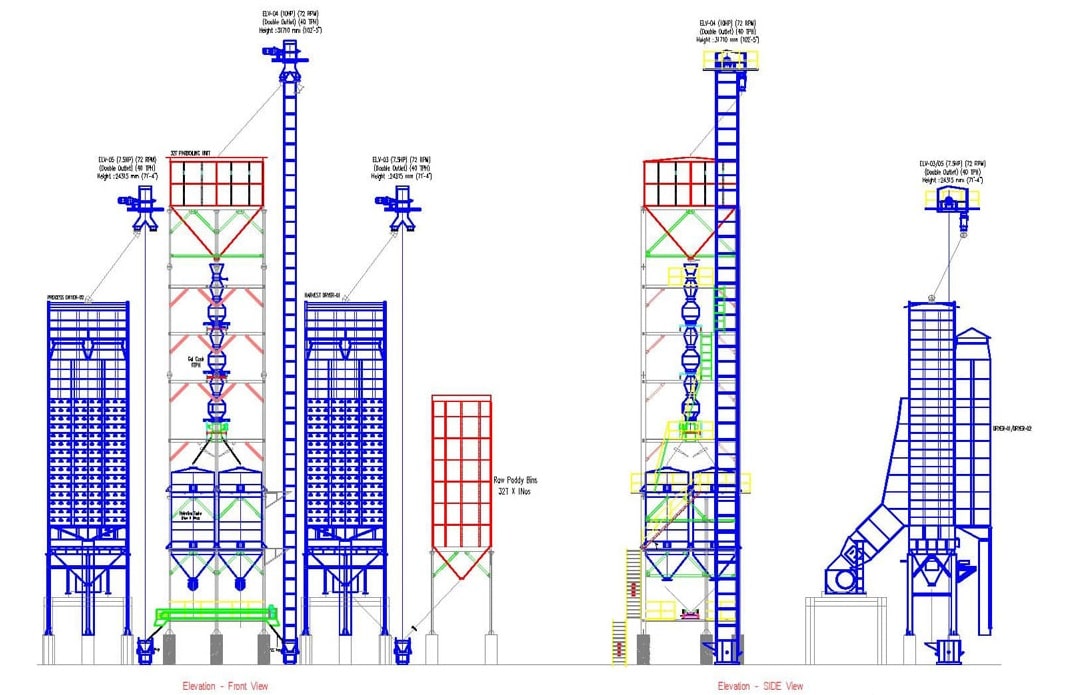
Rice Super Ageing Technology
During the ageing process, some physio-chemical properties change. These changes are caused by changes in lipid, protein, and other substances produced from enzyme activities and oxygen during storage. The conventional ageing of rice takes a relatively long time, approximately 4-6 months. This ageing method also requires much space for the storage of paddy, leading to high operating costs. Furthermore, paddy undergoing ageing is susceptible to damage from insects, microorganisms and rodents. It is, therefore, necessary to explore other techniques that can reduce the ageing time and operating cost while, at the same time, maintaining the properties such as appearance and texture to be similar to those obtained by the conventional ageing process.
Super Ageing Plant

Rice ageing involves changes in the physical and chemical composition of the rice grain. Ageing of rice is an important step in post-harvest processing of paddy, as stored rice is preferred to raw rice owing to the improved flavour. It has better commercial value, higher milling yield, and is preferred by consumers in terms of cooked rice texture, flavour and associated parameters.
The process of ageing commences before harvest and continues as an index dependent on time, temperature, and moisture. Rice ageing brings about significant changes in the physicochemical, sensory, cooking and pasting characteristics of rice.
Rice ageing involves changes in the physical and chemical composition of the rice grain. Ageing of rice is an important step in post-harvest processing of paddy, as stored rice is preferred to raw rice owing to the improved flavour. It has better commercial value, higher milling yield, and is preferred by consumers in terms of cooked rice texture, flavour and associated parameters.
The process of ageing commences before harvest and continues as an index dependent on time, temperature, and moisture. Rice ageing brings about significant changes in the physicochemical, sensory, cooking and pasting characteristics of rice.
Accelerated Aged Rice
The natural or conventional ageing process requires the rice to be stored for longer and has higher operational and maintenance costs. But with artificial accelerated ageing, you don’t require as much time and the associated costs are also much lower. Accelerated Aged Rice involves a short duration of thermal treatment and thermal seasoning of the paddy. It induces desirable changes to obtain the best cooking properties and resembles naturally aged rice.
Rice ageing involves changes in the physical and chemical composition of the rice grain. Ageing of rice is an important step in post-harvest processing of paddy, as stored rice is preferred to raw rice owing to the improved flavour. It has better commercial value, higher milling yield, and is preferred by consumers in terms of cooked rice texture, flavour and associated parameters.
The process of ageing commences before harvest and continues as an index dependent on time, temperature, and moisture. Rice ageing brings about significant changes in the physicochemical, sensory, cooking and pasting characteristics of rice.
Outcomes of Ageing
- Least Process Broken Rice
- Zero Process Rejections
- Highest Water Uptake Ratio
- Maximum Volume Expansion
- Extra Elongation of Cooked Rice Kernel
- Maximum Shelf Life of the Cooked Rice
Advantages of Ageing
- All cooking characteristics are the same as naturally aged rice
- Improved cooking and pasting properties
- Maximum fluffiness in between rice kernels
- Exhibits natural sensory properties, and the technology helps in the retention of vitamins/minerals
- Geometrical expansion of cooked grains
- Loss of grain solids after cooking of super-aged rice is very less as compared to freshly harvested rice
Why Is the Ageing of Rice Accelerated?
- To quickly develop the characteristics of naturally aged rice
- To improve the cooking and pasting properties of rice
- To provide rice with fluffiness after cooking
- To provide rice with good taste, by retention of vitamins/minerals and full maturation
- To reduce the loss of grain solids after cooking the rice
- To increase the hardness of rice
Salient Features
- Best Cooking Results
- Expansion in all Geometrical Properties
- Least Discoloration of Grain
- Least Utility Requirements for Process
- Least Process Cost, Higher Profits

